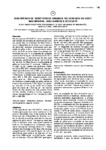Use este identificador para citar ou linkar para este item:
http://www.alice.cnptia.embrapa.br/alice/handle/doc/1028058| Título: | Desempenho de genótipos de girassol no cerrado do leste Maranhense, ano agrícola 2013/2014. |
| Autoria: | RIBEIRO, J. L.  RIBEIRO, V. Q.   CARVALHO, C. G. P. de   GONCALVES, S. L.   |
| Afiliação: | JOSE LOPES RIBEIRO, CPAMN; VALDENIR QUEIROZ RIBEIRO, CPAMN; CLAUDIO GUILHERME PORTELA CARVALHO, CNPSO; SERGIO LUIZ GONCALVES, CNPSO. |
| Ano de publicação: | 2015 |
| Referência: | In: REUNIÃO NACIONAL DE PESQUISA DE GIRASSOL, 21. SIMPÓSIO NACIONAL SOBRE A CULTURA DO GIRASSOL, 9., 2015, Londrina. Anais... Londrina: Embrapa Soja, 2015. |
| Páginas: | p. 145-148. |
| Conteúdo: | RESUMO: No ano agrícola 2013/2014, foram conduzidos três ensaios de avaliação de genótipos de girassol, sendo dois no município de Mata Roma e um em Magalhães de Almeida, com o objetivo de identificar materiais promissores para produção de grãos e óleo. O espaçamento utilizado foi de 0,70 m entre linhas com plantas distanciadas de 0,30 m. A adubação de fundação constou de 200 kg ha-1 da fórmula 05-30-15 + micronutrientes e cobertura aos 30 dias após semeadura, usando-se 30 kg ha-1 de N e 30 kg ha-1 de K2O. Em Mata Roma, a produtividade de grãos no ensaio final 01 variou de 1.866 kg ha-1 a 2.567 kg ha-1, obtida nos genótipos Embrapa 122 e BRS G34, respectivamente, ficando a média geral do ensaio em 2.095 kg ha-1. No ensaio final 02 a produtividade de grãos variou de 1.705 kg ha-1 a 2.036 kg ha -1 para os genótipos Helio 250 e MG 360, REspectivamente, com média geral de 1.834 kg ha-1. Em Magalhães de Almeida a produtividade de grãos obtida no ensaio final constou de 1.600 kg ha-1 no genótipo Helio 251, 2.110 kg ha-1 no CF 101 e média Geral do ensaio de 1.908 kg ha -1. Os maiores teores de óleo obtidos nos três ensaios foram 40,1%, 40,6%, 40,9% e 41,4%, respectivamente, nos genótipos CF 101, Paraíso 20, BRS G41 e MG 360. ABSTRACT: In the agricultural year 2013/2014, three sunflowers genotypes tests were conducted in the state of Maranhão: two in the county of Mata Roma and one in Magalhães de Almeida, in order to identify promising materials for the production of grain and oil. The spacing used was 0.70 m between rows with plants spaced of 0.30 m. The foundation of fertilization consisted of 200 kg ha-1 formula 05-30-15 + micro-nutrient and coverage on 30 days after sowing, using 30 kg ha-1 of N and 30 kg ha-1 of K2O. In Mata Roma, grain yield in the final test 01 ranged from 1,866 kg ha-1 to 2,567 kg ha-1, obtained at Embrapa 122 and BRS G34 genotypes, respectively, getting the overall average of the test in 2,095 kg ha-1. In the final test 02, the grain yield ranged from 1,705 kg ha-1 to 2,036 kg ha-1 for Helio 250 and MG 360 genotypes, respectively, with overall average of 1,834 kg ha-1. In Magalhães de Almeida the grain yield obtained in the final test consisted of 1,600 kg ha-1 in the genotype Helio 251, 2,110 kg ha-1 in the CF 101 and overall average test of 1,908 kg ha-1. The highest oil content obtained in the three tests were 40.1%, 40.6%, 40.9% and 41.4%, respectively, in the 101 CF genotypes, Heaven 20, BRS G41 and MG 360. |
| Thesagro: | Girassol Melhoramento genético vegetal Genótipo Performance Helianthus Annuus |
| NAL Thesaurus: | Plant breeding Genotype Agronomic traits Fruits |
| Palavras-chave: | Aquênio |
| Tipo do material: | Artigo em anais e proceedings |
| Acesso: | openAccess |
| Aparece nas coleções: | Artigo em anais de congresso (CNPSO)  |
Arquivos associados a este item:
| Arquivo | Descrição | Tamanho | Formato | |
|---|---|---|---|---|
| RNPG.p145148.pdf | 166,73 kB | Adobe PDF |  Visualizar/Abrir |









